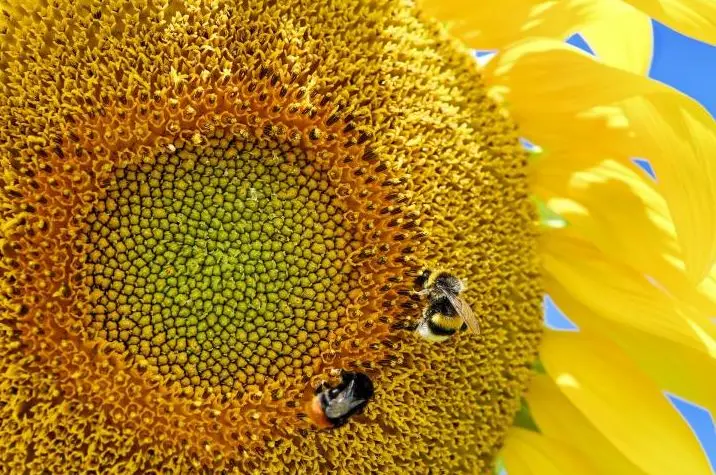[metaslider id=”2827″]Nowadays, on a hot July in Minnesota, one can easily discover buzzing plots of prairie beneath renewable energy producing ground mounted solar arrays. The rows of angled solar panels providing a safe haven structure for shade tolerant flowers as well as space for sun-loving plants. This pollinator-friendly “solar sanctuary” concept nourishes the natural environment, the renewable energy industry and humanity.
This partnership of “solar sanctuaries” and honeybees is a creative response to the worldwide continued devastation of the honeybee population owing to habitat loss, disease, mounting exposure to pesticides, fungicides and herbicides. As pollinators of more than 100 fruit and vegetable crops in the United States, honey bees are a vital contributor to a sustainable environment. From pollinating the produce we eat to providing key ingredients for medicine. Honeybees are uniquely important to our natural surroundings.
The Department of Natural Resource experts began collaborating with natural resource professionals several years ago to create a guide that would pair solar installers who create large shade-throwing arrays with experienced native seed and prairie restoration firms. With the goal of using sustainable solar energy and its structures to offer a protective and nurturing environment for the sustainability of honeybees and develop a consistent standard for pollinator habitat. The Minnesota Board of Water and Soil Resources also developed a “standard” in cooperation with the DNR. And in May of 2016 the Minnesota Legislature passed a statute that encourages the solar industry to consult both the guidelines and the standard.
Small solar gardens are permitted by local governments. Projects that generate 50 megawatts or more need a permit from the Minnesota Public Utilities Commission, which relies on the Department of Natural Resources to review projects for environmental impacts. The DNR recommends ways to minimize impacts or add environmental enhancements.
In 2016, a new suggestion was added: Use the space between the panels and around the edges to support pollinators. A solar array consists of rows of angled solar panels rooted to the ground with steel posts, with typically 15-foot spaces between the rows of solar panels. Beneath the solar array, shade-tolerant flowers and grasses are seeded, while sun-loving plants fill the 15-foot spaces between the rows of solar panels. Such wildlife and pollinator-friendly solar arrays can be constructed on smaller private property or can be part of a larger development or solar garden.
Minnesota’s guidelines and standards have been used as a template for solar-site pollinator habitat in five other states: Wisconsin, North Dakota, Iowa, Vermont, and Maryland.
A wonderful local example of this would be Minnesota based Connexus Energy’s Solar Wise Garden. The SolarWise array not only has a bio-diverse mix of low growing and shade-tolerant flowers and grasses providing a safe habitat for honey bees, it takes things a step further by also housing a bee apiary. These hives are home to Bolton Bees which produce a line of SolarWise Honey available for purchase.
This bee-solar partnership has been inspired at a time when bees are struggling to survive.
Creating pollinator friendly habitats is a powerful way to support bees. Bees collect pollen and nectar from resources within a three-mile radius of the hives to use as food. The more healthy options that bees have, the more productive and strong their population will be.
The establishment of native pollinator habitats on solar sites is now widespread, and in many cases a necessary condition of the solar array permit. The movement continues to grow and creative ideas to support pollinators continue to be inspired.
Best Bees is a national company that employs more than 60 beekeepers across the United States and has outposts in 15 states including hives on top of the Fairmont Copley Plaza hotel in Boston, the Exchange Building in Seattle, and the Wells Fargo Center in Denver. Best Bees discovered that hives are very productive in cities, and theorize that the diversity of blooms in community gardens, urban parks, and grassy lots give bees the nutrition they need. Best Bees lease and maintains beehives which can be housed beneath a solar array or other site, producing delicious honey for the property owner!
Whether you are passionate about local energy independence, productive use of farmland, pollinator and wildlife conservation, or water and soil quality, the pollinator-friendly solar array is a simple way to realize more of the benefits people love.
At once protecting the environment and helping create a renewable future!
To learn more about combining solar with your properties natural surroundings contact us at info@TruNorthSolar.com or 612.888.9599 and our Energy Consultants will reach out to you to learn more about your property and your electrical needs!



